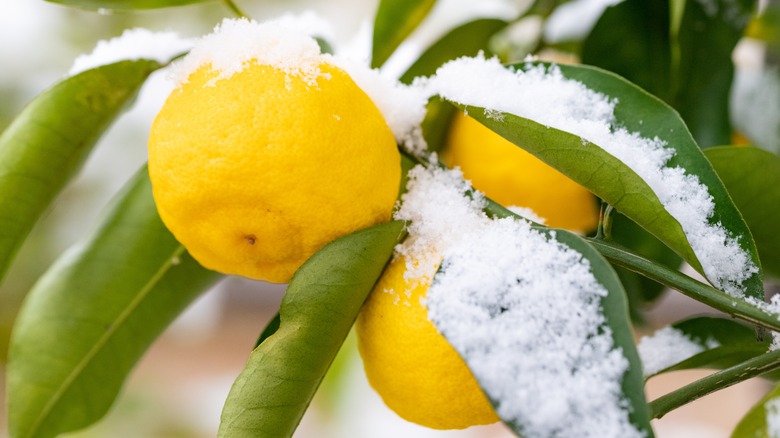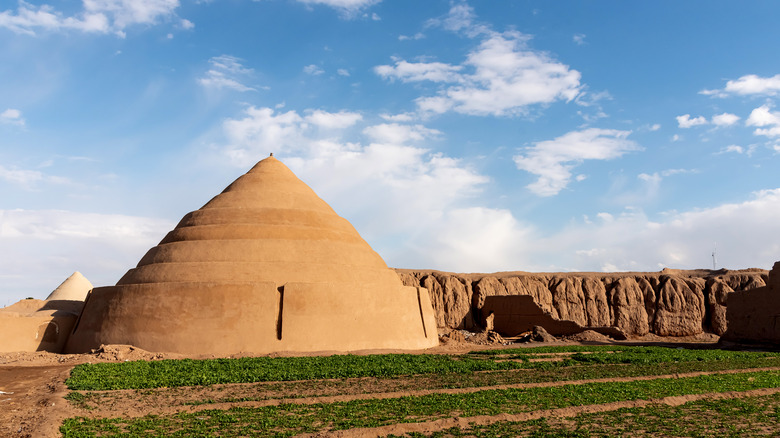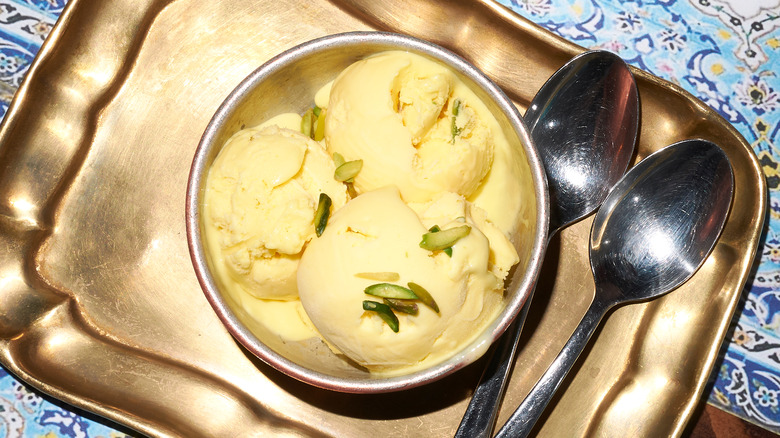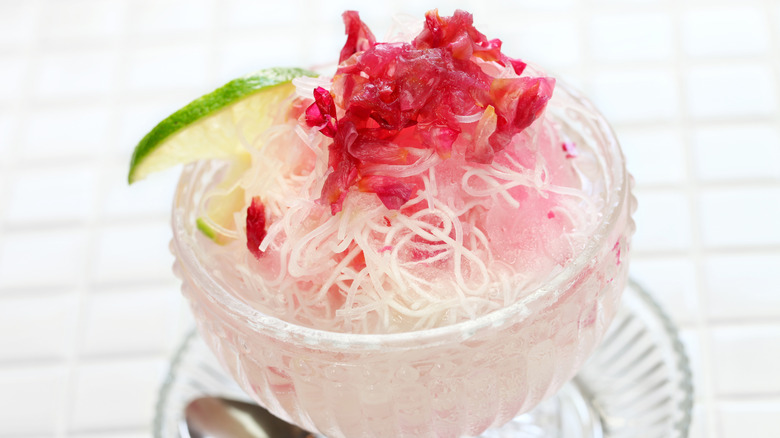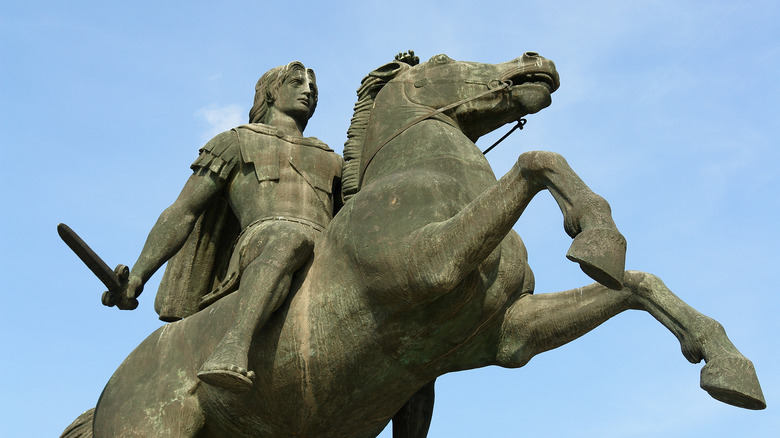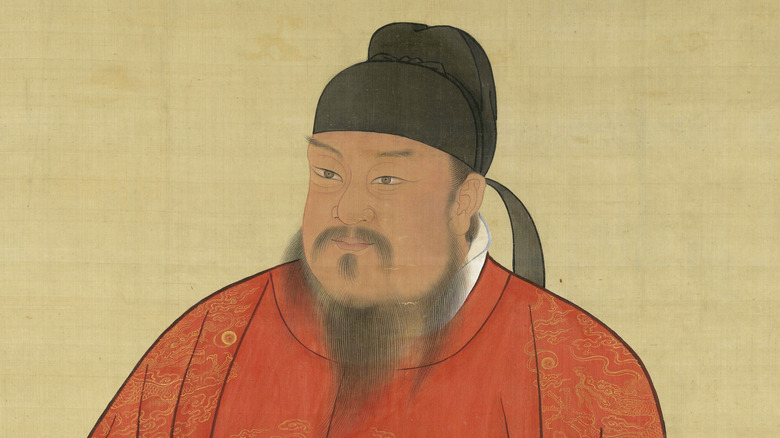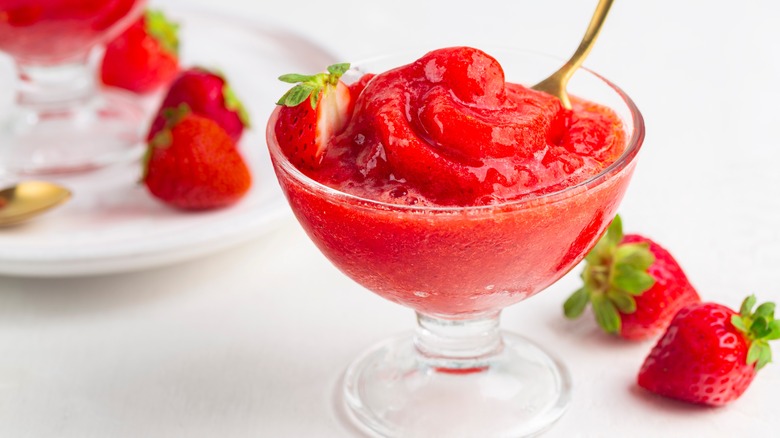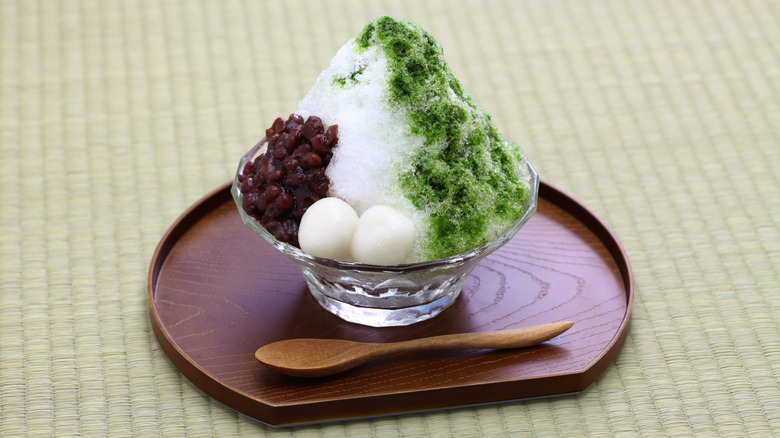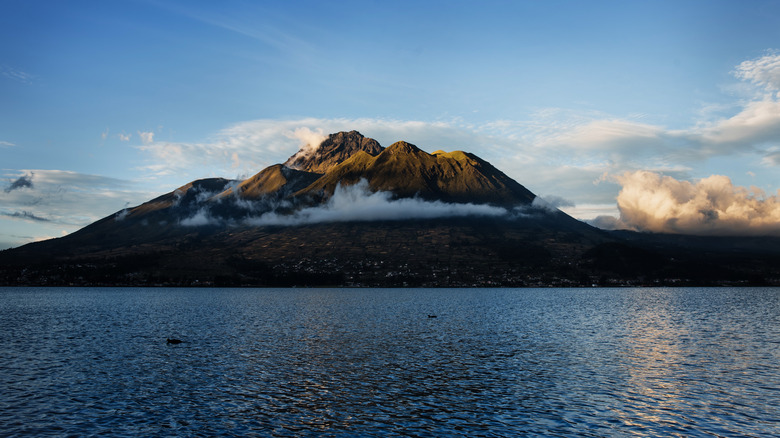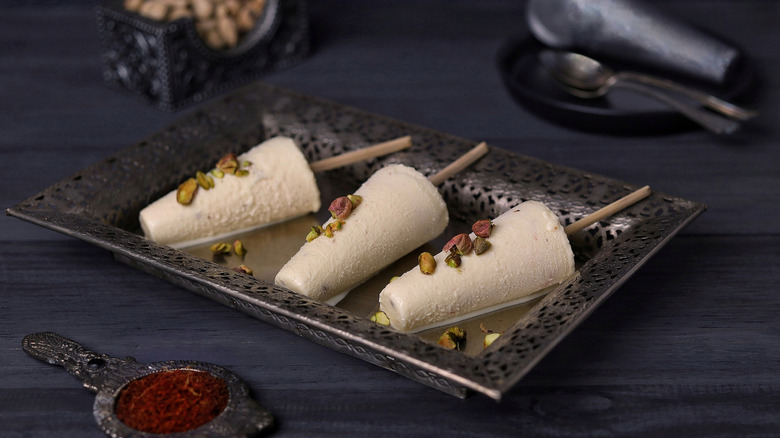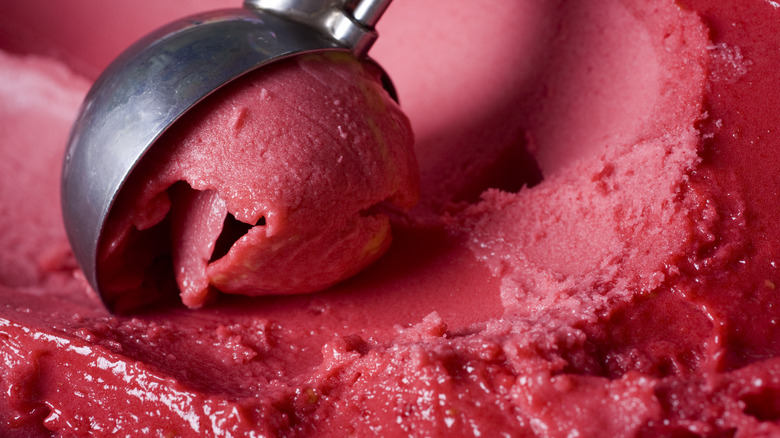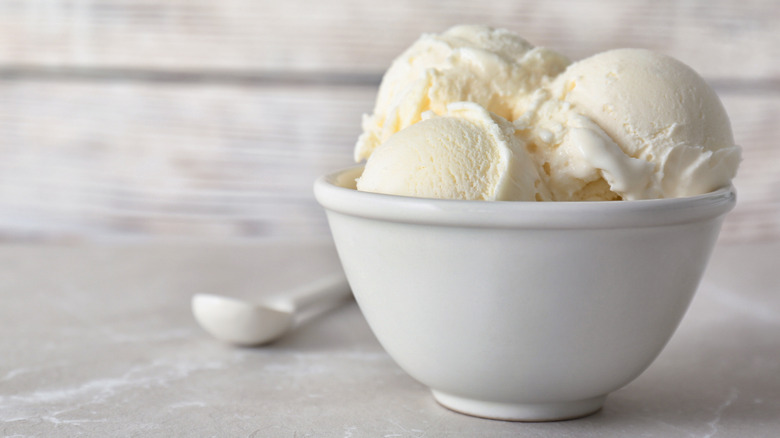The Unexpectedly Ancient History Of Ice Cream
It's easy to think of ice cream as a modern invention, living in a convenient world full of air conditioning and refrigerators. But nothing could be further from the truth. While home refrigerators were first invented in 1913, the history of ice cream stretches back for millennia. What certainly is true, though, is that we live in a time when ice cream has never been more plentiful or abundant. What was once a precious delicacy mostly reserved for kings and emperors is now a sweet treat that anyone can enjoy.
Ice cream's current popularity started in the 18th century when it began to become accessible to the general public. In the early days of the Industrial Revolution, ice cream was enjoyed by children in Europe in much the same way it still is today. The origins of ice cream, however, go back over 2500 years. The oldest recorded ancestor of modern ice cream was served in the ancient Middle East, and its true origins doubtless go back further still.
While these early frozen deserts most definitely contained ice, the cream went largely absent until much later on. Sweetened with ingredients like honey and fruit, while milk was sometimes included, many of these ancient ice creams were probably more like Italian granita or Japanese kakigōri than the ice cream of the modern world.
Desserts made from snow
The true origins of ice cream are lost to time. Most claims for the first ice cream are contested, and there's no shortage of disagreement on both where and when in the world the first frozen desserts were eaten.
The oldest and simplest version of ice cream was certain to be made from natural snow. It's a trick that plenty of people still use today to make snow ice cream – a simple recipe, provided the weather cooperates. In recipes like these, the cream is entirely optional, with fruit juice or purée working perfectly well to make a simple dessert resembling sorbet or granita. Some of ice cream's earliest known ancestors were made from snow in essentially this way. The Ancient Persians reportedly made a dessert consisting of fresh snow mixed with grape juice concentrate. It's mentioned in surviving ancient texts dating back to around 550 B.C.E., making it the oldest frozen dessert ever recorded.
There is one older possibility, but it's a tenuous one. A bowl discovered in an ancient Egyptian tomb is hypothesized to possibly be the world's oldest ice cream bowl. It was split into two halves, which may have contained snow and fruit purée, intended to be combined together at the dining table. If true, this would mean the earliest frozen dessert was eaten as long ago as 2700 B.C.E. It's a controversial idea, though, and unfortunately, there's no way to say for certain what the bowl was once used for.
The huge freezers of ancient Persia
The engineers of the ancient world were ingenious. Two and a half millennia ago, ancient civilizations devised their own way to keep ice readily available all year round — even in the middle of the desert! From around 400 B.C.E., the ancient Persians built structures known as yakhchals during the time of the Achaemenid Empire. These large, domed buildings contained a huge pit that could be filled with ice during the winter, cleverly designed to use wind and evaporating water to keep them cold. Persian nobles would use this ice to make frozen desserts.
In the desert, there was another trick to use. Even at night, the temperatures in the desert seldom drop below freezing, but under a clear sky, water can freeze through the process of night-sky cooling as heat radiates away from Earth's surface. With no cloud cover to trap the planet's warmth, pools of water in the desert can sometimes freeze at night completely naturally this way.
Iced desserts were seemingly quite well-known in the ancient world. They're even mentioned by the Bible in the Proverbs of Solomon. One passage refers to a refreshment as "the cold of snow in the time of harvest," which seemingly alludes to an iced dessert. It's such a seemingly paradoxical statement that some later translations even change this passage to refer to a cold drink instead of snow. No doubt, the translators had trouble believing snow could exist at harvest time.
Persian bastani
Bastani is a sumptuous Persian ice cream, flavored with sweet and fragrant rosewater, pistachios, and saffron which tints it a distinctive yellow color. One key ingredient is salaab, made from a wild orchid with a faintly floral flavor. This extract is used to thicken the ice cream, a little like using corn starch or arrowroot, giving it a stretchier, springier texture than Western ice cream. Easy to find on sale in modern-day Tehran, this beloved dessert is made from a recipe with surprisingly ancient origins.
Traditionally made with sheep's milk, it's been a popular dessert across Iran for over two thousand years. Of any place in the world, Iran has the longest recorded tradition of making and serving frozen desserts. For centuries upon centuries, bastani was stored in the yakhchals together with the ice used to make it. The bastani was reportedly served in the same conical shape as the buildings where it was kept.
Persian faloodeh
Another traditional frozen dessert loved by Iranians is faloodeh. Similarly to some types of Indian kheer, this tasty dish is made from rice vermicelli. The thin noodles are frozen, and typically flavored with rose water and lime juice, topped with some cherry syrup. It's sometimes also made with saffron, giving it the same bright yellow color as bastani. Faloodeh is strongly associated with the city of Shiraz, where it's believed to have originally come from. An ancient city, Shiraz was an important location during the reign of the Seleucid Empire. Faloodeh is believed to have been invented around the same time, dating back to around 400 B.C.E.
Together with bastani, faloodeh is one of the oldest frozen desserts in the world. Without modern technology, making it was originally a slow and laborious process. The traditional method involved a large bowl of ice and a smaller bowl of milk. Setting once inside the other, the milk was stirred continuously while the cold from the ice slowly froze it into ice cream. The result was a dessert quite literally fit for a king, with frozen treats like these being popularly enjoyed by Persian nobility.
Alexander the Great's macedonie
Alexander III of Macedon, better known as Alexander the Great, was one of the most famous military leaders in history. A Greek general, his armies spread eastward from the Mediterranean, conquering everything in their path and eventually building one of the largest empires the world has ever seen. Around 330 B.C.E., it was Alexander who toppled the Achaemenid Empire. He was also extremely fond of ice cream!
Alexander the Great reportedly enjoyed an iced dessert named macedonie, named after his homeland. Macedonie was prepared from fresh snow, mixed with milk and fruit, and flavored with honey. According to legend, Alexander was so enamored with ice cream that he'd order soldiers to travel into the mountains to gather fresh snow for his cooks to prepare it with. These stories are as aggrandizing as you might expect fables of a famous conqueror to be, but it's entirely possible the reality wasn't always quite so ostentatious. After all, with Persia now under his command, he'd have had no shortage of yakhchals to get the ice he needed.
Alexander's sweet tooth may have been inspired by the dessert cuisines from back in Greece. The ancient Greeks were already enjoying frozen desserts by the time Alexander was born, made by mixing snow with honey and fruit. This refreshing treat was very popular in Athens around the 5th century B.C.E.
Ancient Chinese froyo
Some argue that these early iced desserts from around the Mediterranean weren't really ice cream, being mixed with a fair amount of ice or snow. As a result, a dish often cited as the first "true" ice cream comes from ancient China.
In 618 C.E., Gaozu of Tang led a rebellion and seized power, founding the Tang Dynasty. Under Gaozu's orders, one of the world's oldest ice creams was invented. It was made from buffalo milk mixed with flour and, surprisingly, flavored with camphor — now mostly known as an aromatic essential oil. This may seem a strange choice for a flavoring, though perhaps no stranger than the wintergreen ice cream which is popular today in some parts of North America.
Emperor Tang's ice cream needed to be thickened before being frozen, which involved heating the milk with flour. The process also allowed the milk to ferment before the mixture was frozen, ready to be served. The result is that the iced dessert enjoyed by the Tang Dynasty nobility was actually the world's first-ever frozen yoghurt.
Sicilian granita
Today, Italy is world-famous for its ice cream, but exactly when ice cream first reached Italy is a matter of some debate, and probably depends on what definition of ice cream you're using. Some argue that it first arrived when Marco Polo brought the recipe back from China in the 13th century. Others, however, argue that ice cream arrived via Sicily a few centuries earlier.
The 8th century saw the Arab invasion of Sicily, and the conquerors brought their food and culture with them. Popular in the Middle East at the time was an old Persian drink called sharbat, made from fruit syrup and honey chilled with snow. It's usually agreed that this was the origin of granita, Sicily's famous frozen dessert. Granita is now an all-important part of Sicilian food culture, cooled slowly till almost — but never completely — frozen. Like other similar dishes, it's continuously stirred while being chilled, to give a thick, creamy texture. The original recipe, with its Arab influence, was flavored with rose, sandalwood, and citrus. Modern-day granita, though, is served in a variety of flavors, including strawberry, lemon, pistachio, almond, and coffee.
Japanese kakigōri
Kakigōri is a Japanese shaved ice dish. Often elaborately presented in a large bowl, this dish may be doused in flavourful fruit syrups or matcha (Japan's famous green tea). It's often also accompanied by things like anko (red bean paste) or dango (chewy rice flour dumplings). In the hot and humid Japanese summertime, this refreshing dessert is extremely popular, and traditional-styled kakigōri shops can be found tucked away in the smaller streets of big cities like Tokyo. It's also a dessert with a long history, having been eaten in Japan for nearly a thousand years.
While kakigōri may be served widely today, like other frozen desserts, it was originally reserved for the upper class. It was first invented around the start of the 11th century, during Japan's Heian period. Considered extremely valuable at the time, it was made from ice frozen during the coldest part of winter, which was harvested and stored in ice houses. Blocks of this ice were shaved with a knife into metal bowls, and drizzled with syrups made with sweet saps from hydrangeas and vines like lianas. Possibly the oldest reference to kakigōri in Japanese literature was written by Sei Shōnagon in The Pillow Book, published in 1002 C.E.
Ecuador's paila
Completely independently, on the other side of the world, another iced dessert was invented a few centuries later. Paila is a traditional dish from Ecuador that dates back to the days of the Inca Empire in the 15th century — though there's some disagreement on whether it was invented before or after Ecuador came under the control of the Incas.
In Pre-Columbian South America, the Caranquis people sent expeditions to the peak of the volcano Imbabura to gather snow and ice. Wrapping their frosty payload with thick layers of ice and straw, they kept it well enough insulated that they could carry it all the way back down from the summit.
The paila made with this snow was essentially a kind of sorbet, mixed in a large copper cauldron with fruit juices and sugar — although it sometimes included milk, too. The mixture was then stirred vigorously and continuously until it reached a thick, creamy consistency. Using essentially the same traditional recipe, this dish can still be enjoyed in modern-day Ecuador, under the name of helados de paila.
Indian kulfi
Kulfi is India's version of ice cream, renowned across South Asia, and every bit as indulgent and flavourful as other Indian sweets. Kulfi is a favorite summer treat in India today, with a variety of flavors on sale in stores, though the traditional flavor uses cardamom and nuts. It was first made in the 16th century, during the days of the Mughal Empire. The Medieval Indians harvested snow and transported it back to their cities, but they also discovered a technique to use saltpeter to chill and even freeze water. These tricks allowed Indian chefs to create the first kulfi.
The traditional way to make kulfi was to use a mixture of evaporated milk and ice slush, blended with flavors like saffron and pistachio in a very similar combination to the ingredients used in other popular Indian desserts. This mixture was then poured into metal cones which were packed into a slurry of ice to freeze them, technically creating the world's first ice cream cones! The cone shape used in India was, however, a complete coincidence. The familiar edible ice cream cones we know today wouldn't be invented for a few more centuries, being first made in New York in 1896.
Italian sherbet and gelato
Sherbet is an Italian iced dessert, sometimes better known by the French name of sorbet. It was most likely named after the sharbat introduced to Sicily by Arabs in the 8th century — though this idea is contested, with others arguing Turkish or Latin origins for the name. Whatever the origins, though, sherbet became widely popular across Italy in medieval times, during the 16th century. It found plenty of attention among Italian nobility too, particularly in the courts of the Medici family of Florence.
It was the Medicis who directly caused the invention of Italy's most famous ice cream, gelato. In the 16th century, the family sponsored a competition to find the greatest frozen dessert, although the winner was essentially a variation of sherbet. With the reputation the competition gained them, they later commissioned a chef to prepare a feast to impress the visiting King of Spain. The chef, Bernardo Buontalenti, was also an artist and architect, and his creativity in the kitchen saw the invention of a creamy frozen dessert made with cream and egg yolks. That same dessert would later become the gelato we now know and love. The first gelato would eventually reach the US in 1770, but wouldn't become popular in North America until the 1900s.
English cream ice
When Catherina di Medici married the King of France around the mid-16th century, she introduced numerous things to the rest of Europe, and one of those was ice cream. Akin to sorbet, a dessert enjoyed in the French court was made from a thick, half-frozen cream. This dish would soon find its way into the English-speaking world under the name of "cream ice."
In 1625, King Charles II of England married Henrietta Maria, the granddaughter of Catherina di Medici, who brought her two chefs to England with her from France. Cream ice was first served in England at a royal banquet in 1671 with strawberries. It was such a rare dish at the time that there was only enough to serve at the king's own table, with the other guests having to watch them. The cream ice proved to be so popular with the English nobility that many started building ice houses on their estates, where they could store ice to freeze the cream to make it.
The recipe for cream ice, however, was kept a closely guarded secret until the 18th century. Exclusively enjoyed by the wealthy, those who could make it were guaranteed to always find work in the kitchens of manor houses and castles (while probably also enjoying a little themselves in secret). The first recipe for cream ice was eventually published in 1718. The rest, as they say, is history.

